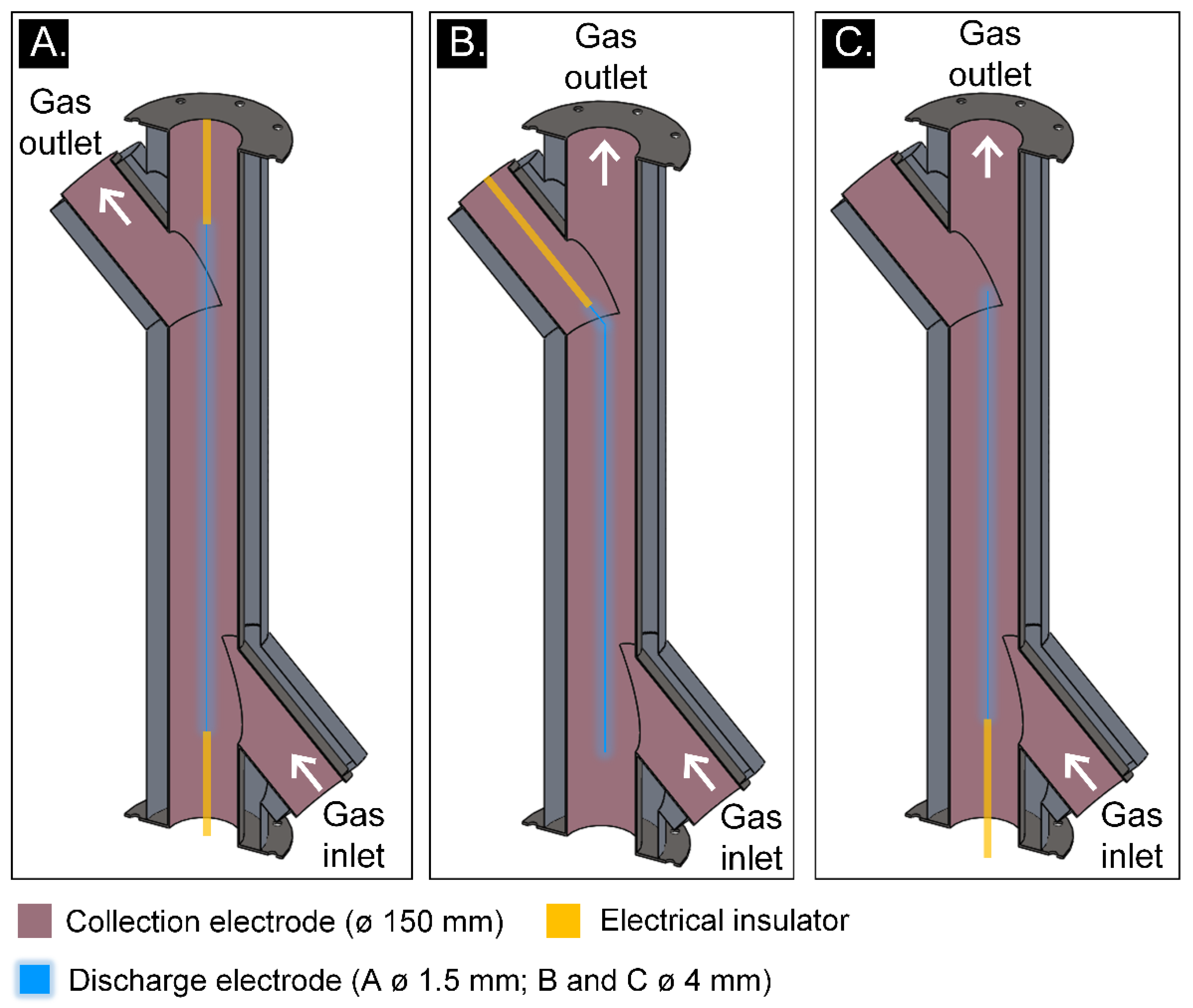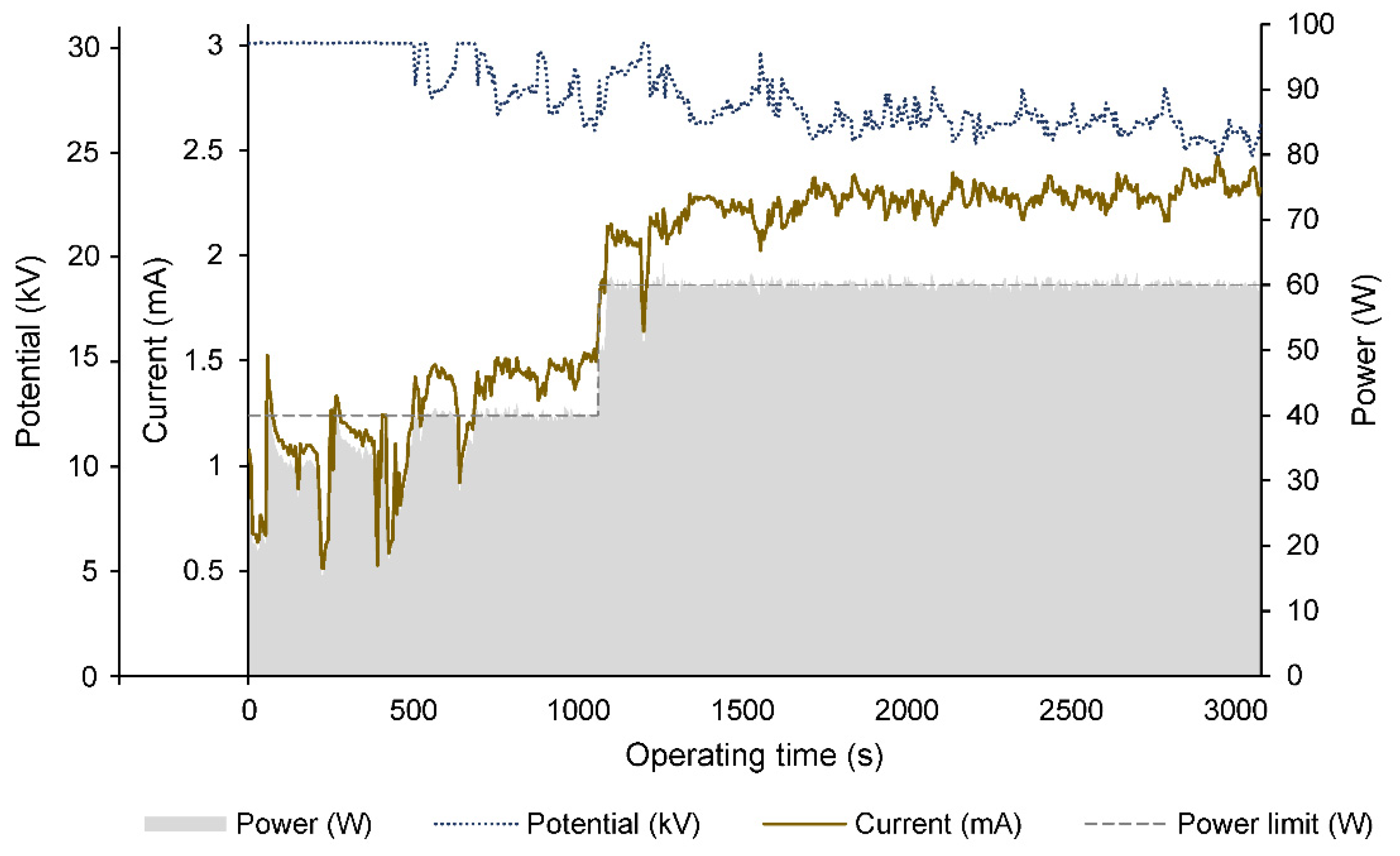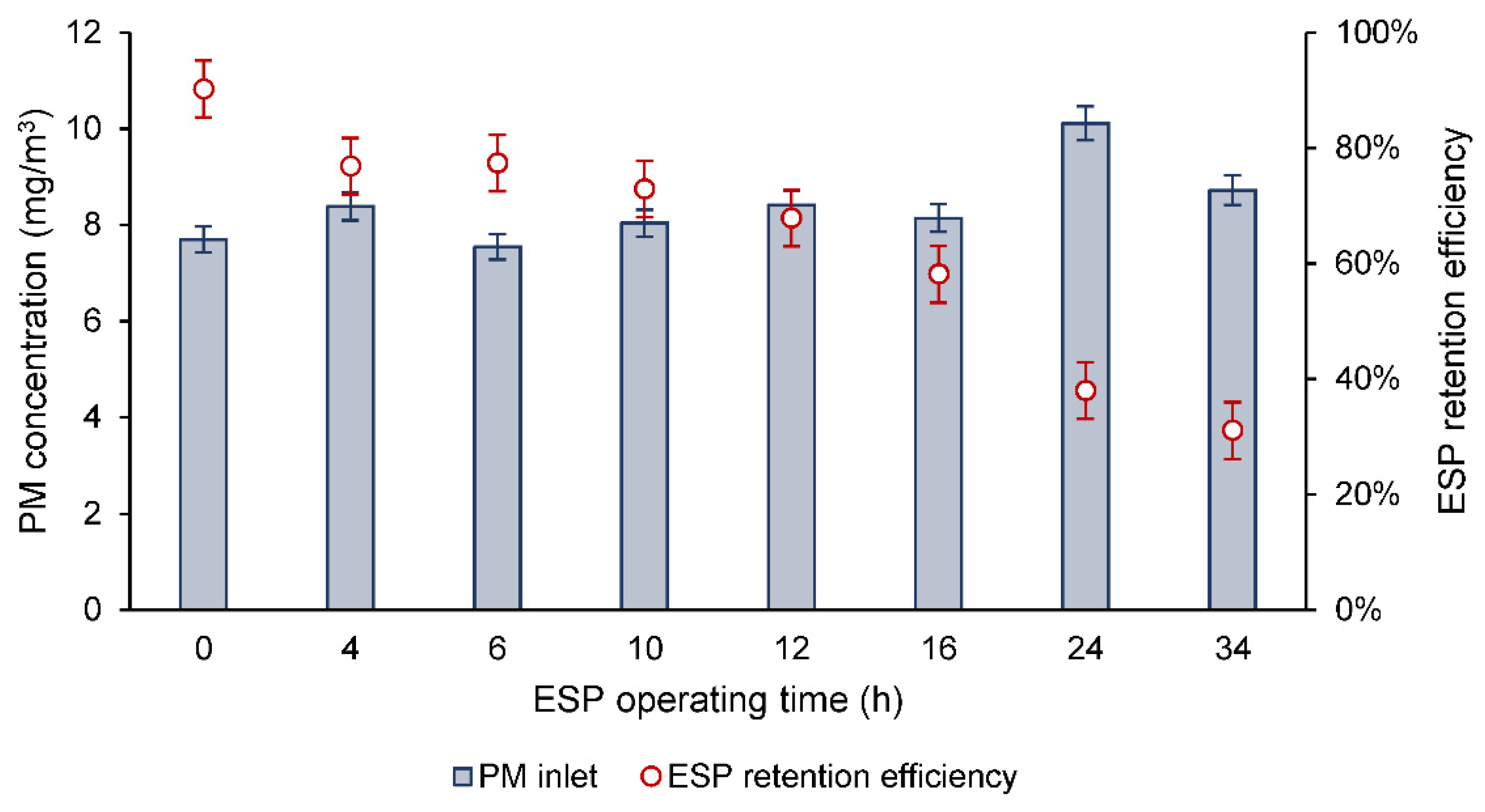Experimental Study of the Performance of a Laboratory-Scale ESP with Biomass Combustion: Discharge Electrode Disposition, Dynamic Control Unit and Aging Effect
Abstract
1. Introduction
2. Materials and Methods
3. Results
3.1. Discharge Electrode Dispositions
3.2. Dynamic Control of the ESP
3.3. Effect of the Operating Time on ESP Performance
4. Conclusions
Author Contributions
Funding
Acknowledgments
Conflicts of Interest
References
- Rico, J.J.; Pérez-Orozco, R.; Cid, N.; Larrañaga, A.; Míguez Tabarés, J.L. Viability of Agricultural and Forestry Residues as Biomass Fuels in the Galicia-North Portugal Region: An Experimental Study. Sustainability 2020, 12, 8206. [Google Scholar] [CrossRef]
- Jesús Rico, J.; Patiño, D.; Cid, N.; Pérez-Orozco, R. PM reduction and flame confinement in biomass combustion using a porous inert material. Fuel 2020, 280, 118496. [Google Scholar] [CrossRef]
- Patiño, D.; Crespo, B.; Porteiro, J.; Villaravid, E.; Granada, E. Experimental study of a tubular-type ESP for small-scale biomass boilers: Preliminary results in a diesel engine. Powder Technol. 2016, 288, 164–175. [Google Scholar] [CrossRef]
- Betancourt Astete, R.; Gutiérrez-Cáceres, N.; Muñoz-Catalán, M.; Mora-Chandia, T. Direct Improvement in the Combustion Chamber and the Radiant Surface to Reduce the Emission of Particles in Biomass Cooking Stoves Used in Araucanía, Chile. Sustainability 2021, 13, 7205. [Google Scholar] [CrossRef]
- Pérez-Orozco, R.; Patiño, D.; Porteiro, J.; Míguez, J.L. Novel Test Bench for the Active Reduction of Biomass Particulate Matter Emissions. Sustainability 2020, 12, 422. [Google Scholar] [CrossRef]
- Kim, K.-H.; Kabir, E.; Kabir, S. A review on the human health impact of airborne particulate matter. Environ. Int. 2015, 74, 136–143. [Google Scholar] [CrossRef]
- Traboulsi, H.; Guerrina, N.; Iu, M.; Maysinger, D.; Ariya, P.; Baglole, C.J. Inhaled Pollutants: The Molecular Scene behind Respiratory and Systemic Diseases Associated with Ultrafine Particulate Matter. Int. J. Mol. Sci. 2017, 18, 243. [Google Scholar] [CrossRef] [PubMed]
- Pérez-Orozco, R.; Patiño, D.; Porteiro, J.; Rico, J.J. The effect of primary measures for controlling biomass bed temperature on PM emission through analysis of the generated residues. Fuel 2020, 280, 118702. [Google Scholar] [CrossRef]
- Patiño, D.; Moran, J.; Porteiro, J.; Collazo, J.; Granada, E.; Miguez, J.L. Improving the Cofiring Process of Wood Pellet and Refuse Derived Fuel in a Small-Scale Boiler Plant. Energy Fuels 2008, 22, 2121–2128. [Google Scholar] [CrossRef]
- Míguez, J.L.; Porteiro, J.; Behrendt, F.; Blanco, D.; Patiño, D.; Dieguez-Alonso, A. Review of the use of additives to mitigate operational problems associated with the combustion of biomass with high content in ash-forming species. Renew. Sustain. Energy Rev. 2021, 141, 110502. [Google Scholar] [CrossRef]
- Pérez-Orozco, R.; Patiño, D.; Porteiro, J.; Larrañaga, A. Flue Gas Recirculation during Biomass Combustion: Implications on PM Release. Energy Fuels 2020, 34, 11112. [Google Scholar] [CrossRef]
- Khodaei, H.; Guzzomi, F.; Patiño, D.; Rashidian, B.; Yeoh, G.H. Air staging strategies in biomass combustion-gaseous and particulate emission reduction potentials. Fuel Process. Technol. 2017, 157, 29–41. [Google Scholar] [CrossRef]
- Regueiro, A.; Patiño, D.; Porteiro, J.; Granada, E.; Míguez, J.L. Effect of Air Staging Ratios on the Burning Rate and Emissions in an Underfeed Fixed-Bed Biomass Combustor. Energies 2016, 9, 940. [Google Scholar] [CrossRef]
- Pérez-Orozco, R.; Patiño, D.; Porteiro, J.; Míguez, J.L. Bed cooling effects in solid particulate matter emissions during biomass combustion. A morphological insight. Energy 2020, 205, 118088. [Google Scholar] [CrossRef]
- Smith, W.J.; Morrin, S.; Timoney, D.J. Effect of operating condition on the particulate matter emission factor for a domestic biomass boiler. Proc. Inst. Mech. Eng. Part A J. Power Energy 2011, 225, 614–618. [Google Scholar] [CrossRef]
- Nugraha, M.G.; Saptoadi, H.; Hidayat, M.; Andersson, B.; Andersson, R. Particulate Matter Reduction in Residual Biomass Combustion. Energies 2021, 14, 3341. [Google Scholar] [CrossRef]
- Commission Regulation. Commission regulation (EU) 2015/1189 of 28 April 2015 implementing Directive 2009/125/EC of the European Parliament and of the Council with regard to ecodesign requirements for solid fuel boilers. Off. J. Eur. Union 2015, 19, 3–5. [Google Scholar]
- Singh, R.; Shukla, A. A review on methods of flue gas cleaning from combustion of biomass. Renew. Sustain. Energy Rev. 2014, 29, 854–864. [Google Scholar] [CrossRef]
- Sippula, O.; Hokkinen, J.; Puustinen, H.; Yli-Pirilä, P.; Jokiniemi, J. Particle Emissions from Small Wood-fired District Heating Units. Energy Fuels 2009, 23, 2974–2982. [Google Scholar] [CrossRef]
- Intra, P.; Limueadphai, P.; Tippayawong, N. Particulate emission reduction from biomass burning in small combustion systems with a multiple tubular electrostatic precipitator. Part. Sci. Technol. 2010, 28, 547–565. [Google Scholar] [CrossRef]
- Lim, M.T.; Phan, A.; Roddy, D.; Harvey, A. Technologies for measurement and mitigation of particulate emissions from domestic combustion of biomass: A review. Renew. Sustain. Energy Rev. 2015, 49, 574–584. [Google Scholar] [CrossRef]
- Poškas, R.; Sirvydas, A.; Poškas, P.; Šimonis, V.; Jankauskas, J. Investigation of the ESP cleaning efficiency of the flue gases in the wide range of Re numbers. Mechanika 2017, 23, 47–54. [Google Scholar] [CrossRef][Green Version]
- Bologa, A.; Paur, H.R.; Ulbricht, T.; Woletz, K. Particle emissions from small scale wood combustion devices and their control by electrostatic precipitation. Chem. Eng. Trans. 2010, 22, 119–124. [Google Scholar] [CrossRef]
- Kim, H.-J.; Han, B.; Kim, Y.-J.; Yoa, S.-J. Characteristics of an electrostatic precipitator for submicron particles using non-metallic electrodes and collection plates. J. Aerosol Sci. 2010, 41, 987–997. [Google Scholar] [CrossRef]
- Ni, M.; Wang, X.; Xiao, G.; Qiu, K.; Yang, G.; Gao, X.; Cen, K. Development of back corona discharge in a wire-cylinder electrostatic precipitator at high temperatures. Powder Technol. 2015, 286, 789–797. [Google Scholar] [CrossRef]
- Chang, C.-L.; Bai, H. An experimental study on the performance of a single discharge wire-plate electrostatic precipitator with back corona. J. Aerosol Sci. 1999, 30, 325–340. [Google Scholar] [CrossRef]
- Migliavacca, G.; Morreale, C.; Hugony, F.; Tombolato, I.; Pession, G. Reduction of pm emissions from biomass combustion appliances: Evaluation of efficiency of electrostatic precipitators. Chem. Eng. Trans. 2014, 37, 25–30. [Google Scholar] [CrossRef]
- Brunner, T.; Wuercher, G.; Obernberger, I. 2-Year field operation monitoring of electrostatic precipitators for residential wood heating systems. Biomass Bioenergy 2018, 111, 278–287. [Google Scholar] [CrossRef]
- Carroll, J.; Finnan, J. Use of electrostatic precipitators in small-scale biomass furnaces to reduce particulate emissions from a range of feedstocks. Biosyst. Eng. 2017, 163, 94–102. [Google Scholar] [CrossRef]
- Oischinger, J.; Steiner, M.; Meiller, M.; Hebauer, M.; Beer, S.; Daschner, R.; Hornung, A.; Kramb, J. Optimization of the fractional collection efficiencies for electrostatic precipitators used in biomass-fired boilers. Biomass Bioenergy 2020, 141, 105703. [Google Scholar] [CrossRef]
- Schmatloch, V.; Rauch, S. Design and characterisation of an electrostatic precipitator for small heating appliances. J. Electrostat. 2005, 63, 85–100. [Google Scholar] [CrossRef]
- Fischer, T.; Graß, N.; Zouzou, N.; Dascalescu, L.; Greil, R.; Hopf, N. Smart home precipitator for biomass furnaces: Design considerations on a small-scale electrostatic precipitator. IEEE Trans. Ind. Appl. 2014, 50, 2219–2224. [Google Scholar] [CrossRef]
- Jaworek, A.; Sobczyk, A.T.; Marchewicz, A.; Krupa, A.; Czech, T. Particulate matter emission control from small residential boilers after biomass combustion. A review. Renew. Sustain. Energy Rev. 2021, 137, 110446. [Google Scholar] [CrossRef]
- Crespo, B.; Patiño, D.; Regueiro, A.; Granada, E. Performance of a lab-scale tubular-type electrostatic precipitator using a diesel engine particle emission source. Energy 2016, 116, 1444–1453. [Google Scholar] [CrossRef]
- Garcia-Maraver, A.; Zamorano, M.; Fernandes, U.; Rabaçal, M.; Costa, M. Relationship between fuel quality and gaseous and particulate matter emissions in a domestic pellet-fired boiler. Fuel 2014, 119, 141–152. [Google Scholar] [CrossRef]
- Verma, V.K.; Bram, S.; Vandendael, I.; Laha, P.; Hubin, A.; De Ruyck, J. Residential pellet boilers in Belgium: Standard laboratory and real life performance with respect to European standard and quality labels. Appl. Energy 2011, 88, 2628–2634. [Google Scholar] [CrossRef]
- Andrade, R.G.S.A.; Guerra, V.G. Discharge electrode influence on electrostatic precipitation of nanoparticles. Powder Technol. 2021, 379, 417–427. [Google Scholar] [CrossRef]






| Wet Basis | Dry Basis | Dry Basis without Ashes | |
|---|---|---|---|
| Humidity (%) | 6.41 | 6.85 | 6.89 |
| Volatile compounds (%) | 68.80 | 73.51 | 73.95 |
| Fixed carbon (%) | 24.23 | 25.89 | 26.05 |
| Ashes (%) | 0.57 | 0.60 | 0.61 |
| Wet Basis | Dry Basis | Dry Basis without Ashes | |
|---|---|---|---|
| C (%) | 44.85 | 47.92 | 48.24 |
| N (%) | 0.24 | 0.26 | 0.26 |
| H (%) | 6.45 | 6.89 | 6.94 |
| S (%) | 0.00 1 | 0.00 1 | 0.00 1 |
| Humidity (%) | 6.41 | 0.00 | 0.00 |
| Ashes (%) | 0.57 | 0.60 | 0.00 |
| O (%) | 41.48 | 44.32 | 44.56 |
| Element | Element in Dry Pellet (mg/kg) | Element in Dry Pellet (%) |
|---|---|---|
| Na | 160.00 | 0.02 |
| Mg | 366.67 | 0.04 |
| Al | 270.00 | 0.03 |
| Si | 586.67 | 0.06 |
| P | 116.67 | 0.01 |
| S | 286.67 | 0.03 |
| Cl | 240.00 | 0.02 |
| K | 1236.67 | 0.12 |
| Ca | 1223.33 | 0.12 |
| Ti | 17.33 | 0.00 |
| Mn | 61.33 | 0.01 |
| Fe | 112.00 | 0.01 |
| Zn | 10.00 | 0.00 |
| Ba | 33.00 | 0.00 |
| Total | 4270.33 | 0.47 |
Publisher’s Note: MDPI stays neutral with regard to jurisdictional claims in published maps and institutional affiliations. |
© 2021 by the authors. Licensee MDPI, Basel, Switzerland. This article is an open access article distributed under the terms and conditions of the Creative Commons Attribution (CC BY) license (https://creativecommons.org/licenses/by/4.0/).
Share and Cite
Cid, N.; Rico, J.J.; Pérez-Orozco, R.; Larrañaga, A. Experimental Study of the Performance of a Laboratory-Scale ESP with Biomass Combustion: Discharge Electrode Disposition, Dynamic Control Unit and Aging Effect. Sustainability 2021, 13, 10344. https://doi.org/10.3390/su131810344
Cid N, Rico JJ, Pérez-Orozco R, Larrañaga A. Experimental Study of the Performance of a Laboratory-Scale ESP with Biomass Combustion: Discharge Electrode Disposition, Dynamic Control Unit and Aging Effect. Sustainability. 2021; 13(18):10344. https://doi.org/10.3390/su131810344
Chicago/Turabian StyleCid, Natalia, Juan Jesús Rico, Raquel Pérez-Orozco, and Ana Larrañaga. 2021. "Experimental Study of the Performance of a Laboratory-Scale ESP with Biomass Combustion: Discharge Electrode Disposition, Dynamic Control Unit and Aging Effect" Sustainability 13, no. 18: 10344. https://doi.org/10.3390/su131810344
APA StyleCid, N., Rico, J. J., Pérez-Orozco, R., & Larrañaga, A. (2021). Experimental Study of the Performance of a Laboratory-Scale ESP with Biomass Combustion: Discharge Electrode Disposition, Dynamic Control Unit and Aging Effect. Sustainability, 13(18), 10344. https://doi.org/10.3390/su131810344







